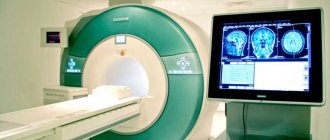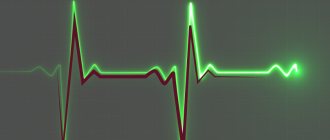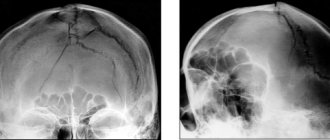An induced coma is actually a medicated sleep. This state differs from anesthesia in the duration of stay in it.
Under the influence of barbiturates, metabolic processes in the nervous tissue slow down. 60% of oxygen and glucose entering the brain support its bioelectrical activity. 40% of oxygen and glucose ensure metabolic processes and other activities.
In a patient in a state of drug-induced sleep, the bioelectrical activity of the brain is significantly reduced, which leads to an increase in free oxygen and glucose, which are redirected to maintain cellular metabolism in the nervous tissue. This is why a person is put into an artificial coma, in order to reduce the negative effects of oxygen deficiency and avoid hypoxic damage to the brain matter.
Artificial coma - what is it?
An artificial coma is a specific state of the body, also called drug-induced sleep, into which the patient is immersed with the help of special medications. A medically induced coma is different from a typical coma and is more like the deep sleep of anesthesia.
When a patient is placed into a medically induced coma, special drugs are used to temporarily slow down the patient's vital functions. Artificial coma is used in the treatment of serious illnesses to reduce the risk of death of the patient.
When a patient is put into an artificial coma, the work of the subcortical parts of the brain is inhibited, reflexes and pain sensitivity are suppressed, the breathing and heart rate decreases, body temperature decreases and muscles relax.
The patient is put into an artificial coma by administering barbiturates, benzodiazepines, ketamine, and propofol. Subsequently, to maintain an induced coma, the patient is administered doses of drugs that support medicinal sleep.
The patient's condition is constantly monitored by specialists (blood gas composition, electrolyte levels, acid-base balance, biochemical blood parameters are monitored).
For reference. It should be noted that the procedure for introducing a patient into an induced coma and further removing it from it is an extremely complex procedure. Therefore, in practice, drug-induced coma is rarely used, only for health reasons, when the potential benefits justify the possible risks associated with the procedure.
Treatment with induced coma
Medically induced coma after surgery often becomes a necessary therapeutic measure to avoid unwanted pathologies and serious danger to life. This method is also used as a replacement for general anesthesia if there is a need for urgent surgery on the brain or in the area of another important organ.
The benefit of artificial coma for stroke is the restoration of nerve cells. The procedure also helps to renew the central nervous system after a stay in intensive care or severe intoxication.
Immersion in an artificial coma during pneumonia allows doctors to carry out important manipulations for the patient’s life and minimize the risk of complications. In case of pneumonia, medicated sleep becomes a last resort and generally does not last long.
Artificial coma - what for?
Induction into an artificial coma is carried out in severe pathologies, when placing the patient on medication is the only way to prevent the development of irreversible changes in organs and tissues.
For reference. Artificial coma can be used to speed up the patient’s recovery after a serious illness or injury, restore damaged nerve tissue, slow down or prevent the development of necrotic processes in tissues against the background of severe hypoxia.
For example, an induced coma helps slow blood circulation and metabolic processes in brain tissue, and therefore can prevent the development of a necrotic lesion and progressive cerebral edema during a major stroke .
Putting a patient into an artificial coma is used for:
- high risk of developing cerebral edema due to trauma, heart attack, stroke, extensive cranial hematomas of non-traumatic injury, brain tumors ;
- extensive burn damage;
- severe life-threatening intoxications;
- intractable seizures and status epilepticus;
- severe alcohol withdrawal syndrome;
- acute psychosis;
- asphyxia of newborns (severe hypoxia of newborns);
- rabies (medically induced coma is used as part of the experimental treatment of rabies; putting the patient into medicated sleep helps prevent the development of severe life-threatening brain damage).
Also, artificial coma is used when performing complex long-term operations on the heart and brain, with combined severe injuries with intense pain (if the patient requires several reconstructive operations, between which there is no point in restoring his consciousness).
What is the benefit
An artificial coma after surgery can be used for restorative purposes.
Most often, coma after surgery is used in the recovery period after extensive neurosurgical operations to provide a neuroprotective effect.
Putting the patient into an induced coma can reduce the risk of severe injuries in patients with prolonged convulsions. With cerebral edema, medicated sleep allows you to slow down metabolic processes in tissues, promotes narrowing of intracranial vessels, normalizes intracranial pressure and allows you to quickly stop the progression of edema.
For reference. Medically induced coma after major surgical interventions can significantly reduce the risk of life-threatening complications and speed up the rehabilitation period.
In case of extensive strokes, putting the patient into an artificial coma helps restore damaged nerve cells, improve the functioning of the central nervous system after general resuscitation, and also prevents the development of necrosis of brain tissue.
If the patient has severe traumatic head injuries, a medically induced coma prevents the development of intracranial hemorrhage.
Introducing medicated sleep to newborns who have suffered severe intrauterine asphyxia allows normalizing metabolic processes in tissues, as well as restoring the functioning of the central nervous system.
Technique for inducing artificial coma
Anesthesiologists and resuscitators induce an artificial coma exclusively in a clinical setting in the intensive care unit. To induce medicinal sleep, intravenously administered sedatives are used, from which the patient quickly loses consciousness and sensitivity.
After the necessary medications are administered, the doctor begins to establish artificial ventilation of the lungs and attaches electrodes to the chest to monitor the work of the heart. If necessary, it is possible to register an electroencephalogram.
Drugs for providing an induced coma are selected individually depending on the goals pursued, the age, weight of the patient, the nature of the underlying disease and concomitant pathology, and the expected duration of the medical coma. Today doctors use:
- Propofol is a drug for intravenous anesthesia, which provides a short duration of coma (only a few hours), has a protective effect on the nervous tissue and blood vessels of the brain, preventing their damage; the duration of coma under the influence of propofol is short, so the risk of adverse reactions is relatively small, and the patient recovers quickly after discontinuation of the drug; over several hours of propofol action, the doctor can easily control the depth of depression of consciousness;
- Benzodiazepines (diazepam) - have anticonvulsant activity, are used as tranquilizers in psychiatry, eliminate sleep problems and can provide a drug-induced coma lasting no more than three days;
- Barbiturates are most often used to create an artificial coma due to their pronounced protective effect on the nervous system and the ability to eliminate cerebral edema with their help; Monitoring brain function under conditions of barbiturate coma is carried out through electroencephalography.
Previously, opiates (narcotic analgesics) could be administered for an induced coma, but due to the high risk of side effects, they were practically abandoned. In addition, there are cases where coma from them developed spontaneously when used as an analgesic.
In neurosurgery, for severe brain damage with a high risk of brain edema, combinations of sedatives and anesthesia drugs (sodium thiopental, sodium hydroxybutyrate) are used. Such drug sedation can reduce blood flow in the brain and the rate of metabolic processes, narrow blood vessels in the brain and reduce intracranial pressure. In addition, induced coma is used in cases where no conservative methods help normalize intracranial pressure.
The state of a medically induced coma differs from any other pathological coma in that it is created purposefully with special drugs. The patient does not breathe independently, the muscles are relaxed, sensitivity is turned off. After awakening, the memory of all past events is retained, but what happened during the period of being in an artificial coma does not remain in memory. This unique protective mechanism promotes better recovery of brain activity, neutralizing the impact of stress from injury or serious illness.
Artificial coma can be used in the practice of neonatologists in case of severe fetal hypoxia during childbirth. Temporarily turning off the baby’s consciousness and putting him into a coma helps slow down metabolism in neurons, restore their function and prevent necrosis.
While in an induced coma, the patient needs constant care. If the coma lasts for a long time, parenteral nutrition is indicated. To prevent bedsores, the patient is turned over in bed every two hours. Hygiene measures, keeping the skin clean, massage, and passive gymnastics to prevent muscle atrophy are important. Close relatives are often involved in the patient's care.
One of the main questions of interest to the patient’s relatives is how long the comatose state will last and how it will affect the body, memory, and the duration of rehabilitation. There is no clear answer to this question, since the duration of drug sedation depends on the severity of the condition, the nature of the pathology, and can range from several hours to a month or more.
As the duration of an induced coma increases, the risks of complications it carries significantly increase. After stopping the administration of sedatives, signs of disorders of the cardiovascular and nervous systems may persist for a long time, and therefore the patient will require long-term rehabilitation.
Features of the use of artificial coma
Introducing the patient into a state of medicated sleep is carried out exclusively in the intensive care unit. The patient is under constant supervision of medical personnel.
To introduce the patient into a state of medicated sleep, the following is used:
- hypnotics used for short-term anesthesia (propofol allows you to put the patient into a state of medical sleep for several hours, and due to its short-term action it has the lowest risk of complications);
- tranquilizers benzodiazepines (diazepam preparations allow you to put the patient into medicated sleep for up to three days);
- barbiturates (provide the best neuroprotective effect for head injuries or strokes, and also help prevent the development of cerebral edema).
The patient's breathing in a state of medicated sleep is supported by ventilation. All functions of internal organs are constantly monitored using hardware and laboratory diagnostics (electrocardiogram, electroencephalogram, blood biochemistry).
For reference. With prolonged drug-induced sleep, the patient is transferred to parenteral (intravenous) nutrition. Mandatory prevention of the development of bedsores and concomitant bacterial infections is also carried out.
Use in resuscitation therapy
An artificial coma is often performed for pneumonia, when acute respiratory failure develops against the background of pneumonia. More often, such pathologies are detected in patients with complicated influenza, who quickly develop viral or bacterial pneumonia and respiratory distress syndrome (a life-threatening condition characterized by diffuse infiltration and hypoxemia - a decrease in the concentration of oxygen in the blood).
Patients are placed in the intensive care unit, where they are sedated with medication and connected to a ventilator. In some cases, patients may remain in this condition for longer than 2 weeks. Typically, the drugs used for sedation are sodium oxybutyrate and benzodiazepines, and for muscle relaxation - Pipecuronium bromide.
In the case of an ischemic stroke , the patient is placed in an induced coma if a large lesion is detected, which is associated with a high risk of progression of neurological disorders - this measure in some cases can improve the outcome of stroke. Severe traumatic brain injuries resulting from an accident, bruise, or attack are associated with acute disruption of blood flow, cerebral edema, dislocation and compression of the brain matter.
For reference. If the patient lies in a coma, cerebral edema decreases, which often leads to stabilization of brain functions; how long the patient needs to remain in this state will be determined by the attending physician. Medication-induced sleep after complex neurosurgery reduces the risk of brain damage.
Often, a comatose state develops spontaneously as a protective reaction of the body to a negative external influence - head injury, impaired cerebral blood flow, taking a large dose of alcohol or a narcotic substance, impaired respiratory and cardiac activity due to complicated, acute somatic pathology.
Your doctor will tell you how to get out of a coma in such cases. Typically, therapeutic measures are reduced to maintaining the vital functions of the body.
The patient regains consciousness on his own or enters a vegetative state (minimal consciousness). The patient can fall asleep and wake up, swallow food, blink, but does not respond to speech at all, does not speak, and does not walk independently.
The duration of the vegetative state, like the coma itself, is difficult to predict. It can last for years and even a lifetime.
Features of carrying out in childhood
Psycho-emotional reactions of patients often complicate the treatment process and negatively affect recovery. Drug sedation as an alternative to local anesthesia is indicated for some types of dental treatment. Painful manipulations, stress, and unfamiliar surroundings negatively affect the child’s psycho-emotional status.
Usually in such cases, adequate doses of hypnotics (hypnotics) or anxiolytics (tranquilizers, psychotropic drugs that eliminate anxiety) are administered. The disadvantage of sedation is that children are unable to answer important questions during sleep that the doctor may have during treatment.
For reference. Deep medicated sleep is indicated in cases where a child is connected to a ventilator. The procedure of tracheal intubation (insertion of a breathing tube into the tracheal cavity) and the lack of speech contact cause discomfort and fear in pediatric patients, which is accompanied by an increase in the concentration of cortisol, a hormone involved in the development of stress reactions.
In parallel, reactions such as increased blood pressure, increased heart rate, and tachypnea (rapid, shallow breathing) occur. In these cases, sodium thiopental or Midazolam is usually used.
"He will live"
Early in the morning of May 23, a new patient was admitted to intensive care unit No. 2 of the Moscow Scientific and Practical Center for Surgery, Transplantation and Hematology. Anesthesiologist-resuscitator Elena Buchkina
does not hide her first impression:
— Mikhail was brought in in extremely serious condition: unconscious, on a ventilator, with strict ventilation parameters. The condition of the lungs was so bad that the body required a high degree of hardware support. The patient was put into a medically induced coma back in Pinsk, with its help he survived the most critical period of his life, so he doesn’t remember anything.
Anesthesiologist-reanimatologist Elena Buchkina
Mikhail’s medical history did not inspire optimism: the course of pneumonia caused by COVID-19 was significantly complicated by concomitant diseases - arterial hypertension, acute kidney damage due to severe inflammation and the patient’s hypersthenic physique.
“When I saw the patient, I thought that it would be very difficult for us to lead him to success. I understood that a long journey awaited us and Mikhail would not be able to avoid all complications. Absolutely all doctors had serious concerns about his prospects. The main thing we provided, in addition to respiratory support, was antibacterial therapy. They put in all kinds of IVs and prescribed medications that improve the functioning of all body systems: respiratory, cardiovascular, kidneys and liver. Three weeks later, I realized: the point that divides the patient’s condition into before and after has been passed. He will live.
Mikhail was gradually brought out of his coma. According to the doctor, when the man came to his senses, he did not even understand what was happening or where he was.
“He heard from us for the first time the whole history of his illness. I would say I received it with surprise and some fear. The man, who was in a coma for almost a month, could not believe that this happened to him - he thought that he fell asleep for a couple of hours and woke up. After weaning off the ventilator, Mikhail breathed humidified oxygen for several days through a tracheostomy tube in his throat, which was later removed. For a few more days he learned to sit down, pedaled his bike, and did physical therapy. When we realized that everything was fine, we transferred him to a regular ward of the thoracic department.
The attending doctors did everything and even a little more to help Mikhail get better.
Today, taking pictures with her patient, Elena glows with happiness. She describes her feelings emotionally: deep satisfaction.
“We are all glad that we were able to give the patient a chance for a new life.” It’s great when the result of your work is successful and your efforts were not wasted.
Alla But-Gusaim also remembers how she called the intensive care unit and every day waited for them to tell her: “Your husband is recovering.”
“The doctors told us everything down to the smallest detail: how Misha survived the night, what progress he was making, how his body was fighting. When they brought him out of the coma, everyone’s mood improved: Misha slowly began to respond to conversations and commands. Then another holiday, when he was sat on the bed for the first time. All this time I was in Pinsk and drove away bad thoughts from myself. I thought only about one thing: everything will be fine with us.
Vladimir Rynkevich, who was interested in the condition of his former patient every day, also hoped for this.
“I was jubilant when Mikhail began to recover. Only then did I exhale and analyze everything. From a professional point of view, I thought: it’s not for nothing that I have the highest category,
— the doctor smiles.
“This disease is new, unknown, it’s nice to know that we are making progress in terms of its treatment. I would like everything to continue to end just as well.
Doctors feel emotional when they manage to give a patient a chance at a second life.
How long does an induced coma last?
The duration of drug-induced sleep is different for each patient and depends on the initial severity of his condition and diagnosis. Since the likelihood of complications directly depends on the duration of the induced coma, doctors try to reduce its duration as much as possible.
In most cases, the patient is put into medicated sleep for several hours or days. Less commonly, a medically induced coma can last up to several months.
“THIS IS NOT A COMA AND NOT AN ANESTHESIA”
— Georgy Nodarevich, you can often hear that when connected to a ventilator, patients are put into an artificial or drug-induced coma...
- No, this is a completely wrong idea! We are by no means talking about a coma. This is correctly called medicated sleep. A person falls into a coma due to severe brain damage - after a stroke, traumatic brain injury, etc. When connecting to a ventilator, we put the patient into medicated sleep precisely in order to protect the brain. This is called neuroprotection. In addition, such a dream performs other tasks.
- Which?
— The ventilator partially replaces the function of the lungs and helps them breathe. To do this, a special tube connected to a ventilator is inserted into the patient's trachea through the throat. It's painful and uncomfortable. And in this state, as a rule, you can stay for quite a long time, sometimes up to several weeks, or even months. That's why we use sedatives and pain relief. With their help, medicated sleep is supported.
- Is it like anesthesia?
— Narcosis is a broader concept. First of all, it involves powerful pain relief. After intubation (insertion of a tube into the trachea) for mechanical ventilation, the constant administration of very strong painkillers is usually not required. We use milder means, usually you can get by with one drug that will induce sleep and the person will be comfortable. The patient's consciousness turns off, he sleeps and does not feel any unpleasant sensations.
— So, patients on mechanical ventilation are always unconscious?
- At first, as a rule, yes. If breathing support with mechanical ventilation needs to be provided for a long time - on average longer than 5-7 days - the patient is given an incision in the throat and a tracheostomy tube is inserted. Artificial ventilation through it is much more comfortable for a person than mechanical ventilation through an endotracheal tube, which is inserted at the initial stage (see above). For some patients, a tracheostomy tube even allows them to feed themselves (not just through a tube) and generally significantly reduces discomfort. In some cases, a decision may be made to partially withdraw from medicinal sleep. A person can be conscious and active while still in the intensive care unit.
Coma state
During a medically induced coma, the following occurs:
- slow breathing;
- decreased heart rate;
- reduction in blood and intracranial pressure;
- muscle relaxation;
- decrease in body temperature;
- slowing down metabolic processes in tissues;
- vasoconstriction;
- decreased kidney function;
- decrease in the amount of fluid in the body;
- decrease in cerebral blood flow rate.
Another indicative manifestation of drug-induced sleep is the patient’s lack of consciousness.
For reference. Breathing during an induced coma is supported by a ventilator.
Diagnosis for coma
It should be noted that coma can cause disability and even death.
A patient in an induced coma is maximally vulnerable to the effects of any negative factors. Therefore, his condition is constantly carefully monitored by medical personnel.
To monitor the effectiveness of treatment, the quality of maintaining medicated sleep and the state of vital signs, the following is used:
- electroencephalogram (allows you to constantly monitor the state of the patient’s cerebral cortex);
- CT and MRI to monitor the patient’s condition and make a further prognosis;
- electrocardiogram (monitoring the state of the patient’s cardiovascular system);
- cerebral angiography (allows for the most accurate assessment of the state of blood circulation in the brain);
- a ventricular catheter that allows you to measure intracranial pressure and the degree of oxygen saturation of the body;
- biochemical blood test, general blood test, assessment of blood oxygen saturation, assessment of acid-base balance and blood electrolyte levels.
For reference. Constant monitoring of the patient’s condition helps prevent the development of complications and promotes timely recovery from drug-induced sleep.
Diagnosis of coma
During the period of stay in a state of artificial coma, it is necessary to diagnose the patient’s condition. The effectiveness of administered medications and the degree of vital activity of the body are controlled using:
- An electroencephalogram, which allows you to monitor the state of the cerebral cortex after head injuries, stroke, etc. For this purpose, a special device (electroencephalograph) designed for round-the-clock operation is connected to the patient’s body.
- Radioisotope control - the introduction into tissue of a special device that monitors blood circulation in parts of the brain.
- Ventricular catheter is a method of changing intracranial pressure, fixing the level of oxygen saturation of tissues and organs, and the flow of metabolism in them.
- CT and MRI, which monitor the state of blood flow, allowing one to make a prognosis regarding the further course of the coma.
Constant monitoring of the patient’s vital functions allows one to avoid cardiac arrhythmias and cardiac arrest, and to ensure timely exit from artificially created sleep.
Medical staff monitors the effectiveness of the drugs used and the depth of the coma created 24 hours a day. To avoid the appearance of bedsores on the patient’s body, he is periodically (several times during the day) turned over in bed.
Why is an induced coma dangerous?
The most common complications of an induced coma are bedsores. In order to avoid their development, the patient’s relatives and medical personnel must periodically change the position in which the patient is, give him a gentle massage, and carefully monitor skin hygiene.
Attention. Due to muscle relaxation, lack of consciousness and impaired swallowing, an induced coma can be complicated by severe aspiration pneumonia associated with the reflux of gastric contents into the lungs.
It is also possible to develop:
- laryngeal stenosis and pulmonary edema (against the background of constant mechanical ventilation (artificial ventilation));
- acute cardiovascular failure;
- collapse;
- renal failure;
- infectious and inflammatory processes in internal organs;
- sepsis.
After the patient is brought out of a medically induced coma, there may be a temporary decrease in memory, impaired speech and motor activity, and lethargy.
The duration of the rehabilitation period in this case will depend on the duration of the induced coma and the severity of the resulting disorders.
For reference. It should be noted that during the first year after drug-induced sleep, approximately every 10 patient manages to return to normal life. In other cases, the period of complete recovery takes a longer period of time.
Recovery after an induced coma
The recovery period after removal from an induced coma requires constant monitoring of the patient, monitoring of cardiac performance, respiration, and metabolism. Doctors of many specialties participate in rehabilitation - resuscitator, neurologist, physiotherapist, psychotherapist, rehabilitologist. A massage therapist helps restore muscle function; for speech disorders, classes are held with a speech therapist; physical therapy is required.
It is important to know that an induced coma does not end suddenly, and the patient will not be able to open his eyes and leave the clinic in the near future. As the effect of sedatives ceases, reflex activity and the functioning of the autonomic nervous system are restored. Consciousness is not restored immediately, it may be confused, episodes of delirium, hyperkinesis and even convulsions are possible. As a rule, neither the coma itself nor the first days of rehabilitation, until consciousness is fully restored, are retained in the patient’s memory.
Removal from an induced coma requires some preparation of the patient. First, a gradual transition to independent breathing is made by briefly periodically turning off the artificial pulmonary ventilation device (for a few seconds, then minutes) until breathing is completely restored, then the patient is activated - they are taught to walk, perform hygiene procedures, eat independently, and develop muscles. Rehabilitation can take several months, during which the patient gains weight, strengthens the musculoskeletal system, and trains memory and speech.
Situations in which an induced coma is used pose a fairly serious health risk: Only every tenth patient manages to return to a normal lifestyle within the first year after treatment. The shorter the coma lasted, the sooner rehabilitation was completed; the longer it was, the higher the likelihood of an unfavorable outcome.
The consequences of an induced coma can be:
- inflammatory processes in the respiratory system - bronchitis, pneumonia;
- laryngeal stenosis, pulmonary edema due to artificial ventilation;
- acute heart failure, collapse;
- neurological disorders - impaired memory, speech, motor activity, etc.;
- bedsores;
- renal failure;
- infectious and inflammatory changes in internal organs, sepsis.
Constant lying down contributes to the formation of bedsores, and muscle relaxation, lack of consciousness and swallowing can lead to the entry of stomach contents into the respiratory system and severe aspiration pneumonia.
Despite the fact that in some cases, a medically induced coma helps save lives, the prognosis for this method of treatment remains extremely serious, especially if the patient has suffered severe trauma or extensive cerebral infarction. After a coma that lasted several months, approximately half of the patients die from complications or are left to live with serious health problems, a third become disabled, and only every tenth manages to achieve a level of health acceptable for normal life.
How to be brought out of an induced coma
Bringing a patient out of an induced coma is an extremely complex procedure that requires special training. The administration of medications that support the patient's medicated sleep is stopped gradually.
Relatives of the patient need to understand that recovery from a coma and further rehabilitation can last many months.
The patient's consciousness is restored gradually, periods of delirium, memory impairment, speech impairment and motor activity are possible.
For reference. During rehabilitation, patients gradually learn to eat, get out of bed, and walk on their own. Restoring memory, speech and motor activity can take from several months to a year.
Intravenous drug sedation
The procedure is a process of immersion in a medicated sleep in a relaxed state.
Preparations based on midazolam, sodium thiopental, and propofol are used. Narcotic analgesics are not used. Intravenous drug sedation has only a hypnotic effect.
The procedure has many advantages compared to general anesthesia, including:
- Immersion in medicated sleep occurs instantly.
- The degree of amnesia is the most effective.
- Possibility of carrying out in the presence of somatic diseases.
- Controlling the depth of sleep.
- No nitrous oxide is released.
Why is it carried out?
Direct indications for intravenous drug sedation are:
- Surgical procedures.
- The patient has pathologies of the central nervous system. For example, epilepsy, autism.
- Emotional stress, anxiety.
- Intolerance to pain medications.
- Contraindications to general anesthesia.
- Long operation.
- This type of sedation is often used in colonoscopy and gastroscopy.
Safety of the procedure
An experienced doctor at our clinic prevents overdose by administering the substance in small portions.
During treatment, the anesthesiologist monitors the patient's condition (blood oxygen level, heart rate, blood pressure) through a heart monitor. If necessary, fluid deficiency is replenished, blood clotting is regulated with non-steroidal medications. The resuscitator always has a drug on hand that is an antidote to sedation.
The safety of intravenous sedation is confirmed by the absence of respiratory depression and gagging.
How is it carried out?
The patient comes on an empty stomach and takes a “lying” position. The doctor, taking into account weight, age, existing diseases of the central nervous system, selects the dosage of the drug.
The drug is injected into a vein on the elbow using a syringe dispenser. In this case, no pain or discomfort occurs. The doctor talks with the patient, assesses the condition based on the answers and coherence of speech. Gradually the patient falls into sleep, which is similar to physiological sleep.
In some cases, when the veins are not visible, the patient is first put to sleep through a mask. Only after anesthesia are sedatives administered.
Recovery period
The patient comes out of medicated sleep in the presence of an anesthesiologist and medical workers. The doctor restores the autoregulation mechanism.
Unlike general anesthesia, the person being operated on gently comes out of the state of drug-induced sleep. After the person has come to his senses, it is recommended to remain calm. It is necessary to limit physical activity and actions that require increased attention.
Total rehabilitation time is about two hours. Before discharging the patient home, the doctor lists a small list of restrictions:
- Don't drink alcohol for one week.
- Don't drive a car for two days.
- Limit physical activity for about a week.
Experience of Health Clinic specialists
When performing the procedure, you can be confident in the professionalism of the doctor. The clinic employs an anesthesiologist with more than 20 years of experience. The specialist applies all his knowledge, selects the right type of painkiller, based on the condition of each patient.
Patients of the Diagnostic Center are provided with free parking. Reservation of a place for a car is made no later than an hour before arrival at the clinic. Call
SERVICES
| Name of service | Cost in rubles |
| Intravenous drug sedation | 3000 |
If you do not find the service in the price list, please call us at +7 (495) 961-27-67 and
+7, You will be given the necessary information.
You can sign up for a consultation by calling +7(495) 961-27-67
(treatment center on Novokuznetskaya metro station)
come back
Forecast for recovery
The prognosis is always extremely serious. First of all, due to the fact that patients are put into an artificial coma only in the presence of severe pathologies.
The further prognosis for rehabilitation and recovery depends on the main diagnosis, the duration of the medically induced coma, the patient’s age, the presence of concomitant pathologies and complications.
Important. The longer the patient is in an induced coma, the longer the further recovery period and the lower the likelihood of full recovery.
The most optimistic prognosis is observed in patients who were put into a short-term medical coma - up to several hours. There is also a good prognosis for complete rehabilitation in patients who have been in a medical coma for up to several days.
How does anesthesia work?
Any anesthesia, local or general (the latter is also called anesthesia), is a medicinal intervention in the body that helps to avoid pain stress. In response to a pain impulse from the injured area, pain awareness occurs in the cerebral cortex. To prevent this, you need to block the nerve endings. Local anesthesia stops the transmission of pain impulses in a certain area - the medicine passes through the cell membranes and disrupts the reactions in them. As a result, nerve impulses are blocked and the sensation of pain does not occur. Consciousness is preserved during local anesthesia, and the effect lasts on average one to two hours. Anesthesia, or general anesthesia, is an effective method when a large area of the body is undergoing intervention. In this state, the person sleeps soundly and is well relaxed: tension in the muscles and other tissues should not interfere with the surgeon’s work.
Oleg Karmanov notes that it is wrong to be afraid of damage from the anesthetic: enduring pain is much more dangerous. In many cases, the risk of losing your life from painful shock during surgery without anesthesia is very high. According to the doctor, modern anesthetics are well controlled. This means that as soon as the active substance is no longer introduced into the body, it quickly disintegrates and the patient wakes up. The only absolute contraindication is an allergy to the drugs used, and possible side effects are usually associated with the presence of additional substances in the solution: vasoconstrictors (vasoconstrictors), preservatives and stabilizers.









